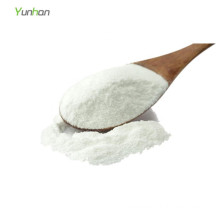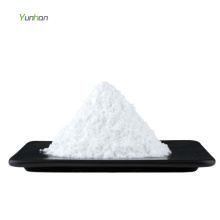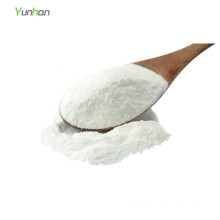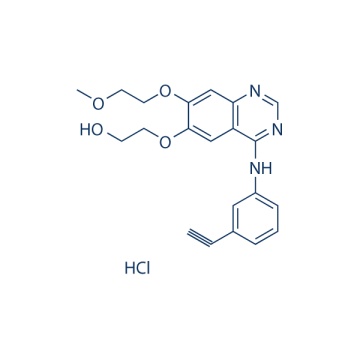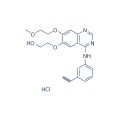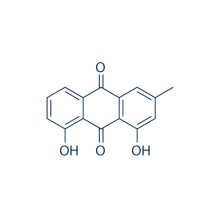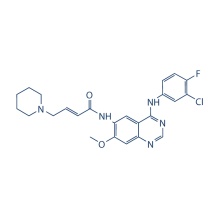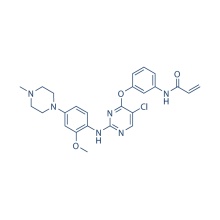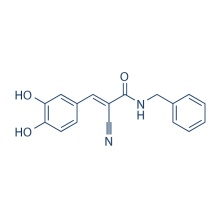OSI-420 183320-51-6
Product Description
.cp_wz table {border-top: 1px solid #ccc;border-left:1px solid #ccc; } .cp_wz table td{border-right: 1px solid #ccc; border-bottom: 1px solid #ccc; padding: 5px 0px 0px 5px;} .cp_wz table th {border-right: 1px solid #ccc;border-bottom: 1px solid #ccc; padding: 5px 0px 0px 5px;}
Molecular Weight:
415.87 OSI-420 is the active metabolite of Erlotinib (EGFR Inhibitor with IC50 of 2 nM).
Biological Activity
OSI-420 is the major metabolite of Erlotinib in human plasma. Erlotinib
disappearance from plasma after a short IV infusion is biexponential
with a mean terminal half-life of 5.2 h and a mean clearance of 128
ml/min per m(2). OSI-420 exposure (AUC) in plasma is 30% (range 12-59%)
of erlotinib, and OSI-420 clearance is more than 5-fold higher than
erlotinib. Erlotinib and OSI-420 are equipotent, and the combined
concentrations of erlotinib + OSI-420 achieved in the CSF exceeded the
IC50 (7.9 ng/ml or 20 nM) for the EGFR tyrosine kinase inhibition in
intact tumor cells.
Erlotinib potently inhibits EGFR
activation in intact cells including HNS human head and neck tumor cells
(IC50 20nM), DiFi humancolon cancer cells andMDA MB-468 human breast
cancer cells. Erlotinib (1 μM) induces Apoptosis in DiFi humancolon
cancer cells. Erlotinib growth of a panel of NSCLC cell
lines including A549, H322, H3255, H358 H661, H1650, H1975, H1299, H596
with IC50 ranging from 29 nM to >20 μM.
Erlotinib(2 μM) significantly inhibits growth of AsPC-1 and BxPC-3 pancreatic cells. The effects of Erlotinib HCl in combination with gemcitabine are
considered additive in KRAS-mutated pancreatic cancer cells. Ten
micromolar of Erlotinib inhibits EGFR phospho-rylation at the Y845
(Src-dependent phosphorylation) and Y1068 (auto-phosphorylation) sites. Combination with Erlotinib could down-modulate rapamycin-stimulated Akt
activity and produces a synergistic effect on cell growth inhibition.
At doses of 100 mg/kg, Erlotinib completely prevents EGF-induced
autophosphorylation of EGFR in human HN5 tumors growing as xenografts in
athymic mice and of the hepatic EGFR of the treated mice. Erlotinib reduces the growth of xenografted human AML cells.
Protocol(Only for Reference)
Kinase Assay: [1]
Cell Assay: [3]
Animal Study: [7]
Conversion of different model animals based on BSA (Value based on data from FDA Draft Guidelines)
For example, to modify the dose of resveratrol used for a mouse (22.4 mg/kg) to a dose based on the BSA for a rat, multiply 22.4 mg/kg by the Km factor for a mouse and then divide by the Km factor for a rat. This calculation results in a rat equivalent dose for resveratrol of 11.2 mg/kg.
Chemical Information
Molarity Calculator
Dilution Calculator
Molecular Weight Calculator
Contact us if you need more details on 183320-51-6. We are ready to answer your questions on packaging, logistics, certification or any other aspects about OSI-420 183320-51-6、183320-51-6 OSI-420. If these products fail to match your need, please contact us and we would like to provide relevant information.
Molecular Weight:
415.87 OSI-420 is the active metabolite of Erlotinib (EGFR Inhibitor with IC50 of 2 nM).
Biological Activity
OSI-420 is the major metabolite of Erlotinib in human plasma. Erlotinib
disappearance from plasma after a short IV infusion is biexponential
with a mean terminal half-life of 5.2 h and a mean clearance of 128
ml/min per m(2). OSI-420 exposure (AUC) in plasma is 30% (range 12-59%)
of erlotinib, and OSI-420 clearance is more than 5-fold higher than
erlotinib. Erlotinib and OSI-420 are equipotent, and the combined
concentrations of erlotinib + OSI-420 achieved in the CSF exceeded the
IC50 (7.9 ng/ml or 20 nM) for the EGFR tyrosine kinase inhibition in
intact tumor cells.
Erlotinib potently inhibits EGFR
activation in intact cells including HNS human head and neck tumor cells
(IC50 20nM), DiFi humancolon cancer cells andMDA MB-468 human breast
cancer cells. Erlotinib (1 μM) induces Apoptosis in DiFi humancolon
cancer cells. Erlotinib growth of a panel of NSCLC cell
lines including A549, H322, H3255, H358 H661, H1650, H1975, H1299, H596
with IC50 ranging from 29 nM to >20 μM.
Erlotinib(2 μM) significantly inhibits growth of AsPC-1 and BxPC-3 pancreatic cells. The effects of Erlotinib HCl in combination with gemcitabine are
considered additive in KRAS-mutated pancreatic cancer cells. Ten
micromolar of Erlotinib inhibits EGFR phospho-rylation at the Y845
(Src-dependent phosphorylation) and Y1068 (auto-phosphorylation) sites. Combination with Erlotinib could down-modulate rapamycin-stimulated Akt
activity and produces a synergistic effect on cell growth inhibition.
At doses of 100 mg/kg, Erlotinib completely prevents EGF-induced
autophosphorylation of EGFR in human HN5 tumors growing as xenografts in
athymic mice and of the hepatic EGFR of the treated mice. Erlotinib reduces the growth of xenografted human AML cells.
Protocol(Only for Reference)
Kinase Assay: [1]
| Kinase Assays | 96-well plates are coated by incubation overnight at 37 °C with 100 μL per well of 0.25 mg/mL PGT in PBS. Excess PGT is removed by aspiration, and the plate is washed 3 times with washing buffer (0.1% Tween 20 in PBS). The kinase reaction is performed in 50 μL of 50 mM HEPES (pH 7.3), containing 125 mM sodium chloride, 24 mM magnesium chloride, 0.1 mM sodium orthovanadate, 20 μM ATP, 1.6 μg/mL EGF, and 15 ng of EGFR, affinity purified from A431 cell membranes. Erlotinib HCl in DMSO is added to give a final DMSO concentration of 2.5%. Phosphorylation is initiated by addition of ATP and proceeded for 8 minutes at room temperature, with constant shaking. The kinase reaction is terminated by aspiration of the reaction mixture and is washed 4 times with washing buffer. Phosphorylated PGT is measured by 25 minutes of incubation with 50 μL per well HRP-conjugated PY54 antiphosphotyrosine antibody, diluted to 0.2 μg/mL in blocking buffer (3% BSA and 0.05% Tween 20 in PBS). Antibody is removed by aspiration, and the plate is washed 4 times with washing buffer. The colonmetric signal is developed by addition of TMB Microwell Peroxidase Substrate, 50μL per well, and stopped by the addition of 0.09 M sulfuric acid, 50 μL per well. Phosphotyrosine is estimated by measurement of absorbance at 450 nm. The signal for controls is typically 0.6-1.2 absorbance units, with essentially no back ground in wells without AlP, EGFR, or PGT and is proportional to the time of incubation for 10 minutes. |
|---|
Cell Assay: [3]
| Cell lines | A549, H322, H3255, H358 H661, H1650, H1975, H1299, H596 cells |
|---|---|
| Concentrations | 30 nM-20 μM |
| Incubation Time | 72 hour |
| Method | Exponentially growing cells are seeded in 96-well plastic plates and exposed to serial dilutions of erlotinib, pemetrexed, or the combination at a constant concentration ratio of 4:1 in triplicates for 72 h. Cell viability is assayed by cell count and the 3-(4,5-dimethylthiazol-2-yl)-2,5-diphenyltetrazolium bromide assay. Growth inhibition is expressed as the percentage of surviving cells in drug-treated versus PBS-treated control cells (which is considered as 100% viability). The IC50 value is the concentration resulting in 50% cell growth inhibition by a 72-h exposure to drug(s) compared with untreated control cells and is calculated by the CalcuSyn software. |
Animal Study: [7]
| Animal Models | Male 5-week-old BALB-nu/nu with HPAC |
|---|---|
| Formulation | 6% Captisol |
| Dosages | 50 mg/kg |
| Administration | Oral administration |
Conversion of different model animals based on BSA (Value based on data from FDA Draft Guidelines)
| Species | Baboon | Dog | Monkey | Rabbit | Guinea pig | Rat | Hamster | Mouse |
| Weight (kg) | 12 | 10 | 3 | 1.8 | 0.4 | 0.15 | 0.08 | 0.02 |
| Body Surface Area (m2) | 0.6 | 0.5 | 0.24 | 0.15 | 0.05 | 0.025 | 0.02 | 0.007 |
| Km factor | 20 | 20 | 12 | 12 | 8 | 6 | 5 | 3 |
| Animal A (mg/kg) = Animal B (mg/kg) multiplied by | Animal B Km |
| Animal A Km |
For example, to modify the dose of resveratrol used for a mouse (22.4 mg/kg) to a dose based on the BSA for a rat, multiply 22.4 mg/kg by the Km factor for a mouse and then divide by the Km factor for a rat. This calculation results in a rat equivalent dose for resveratrol of 11.2 mg/kg.
| Rat dose (mg/kg) = mouse dose (22.4 mg/kg) × | mouse Km(3) | = 11.2 mg/kg |
| rat Km(6) |
Chemical Information
| Molecular Weight (MW) | 415.87 |
|---|---|
| Formula | C21H21N3O4.HCl |
| CAS No. | 183320-51-6 |
| Storage | 3 years -20℃Powder |
|---|---|
| 6 months-80℃in solvent (DMSO, water, etc.) | |
| Synonyms | DesMethyl Erlotinib (CP-473420) HCl |
| Solubility (25°C) * | In vitro | DMSO | 83 mg/mL heating (199.58 mM) |
|---|---|---|---|
| Water | <1 mg/mL ( | ||
| Ethanol | <1 mg/mL ( | ||
| * <1 mg/ml means slightly soluble or insoluble. * Please note that Selleck tests the solubility of all compounds in-house, and the actual solubility may differ slightly from published values. This is normal and is due to slight batch-to-batch variations. | |||
| Chemical Name | 2-(4-(3-ethynylphenylamino)-7-(2-methoxyethoxy)quinazolin-6-yloxy)ethanol hydrochloride |
|---|
Molarity Calculator
Dilution Calculator
Molecular Weight Calculator
Contact us if you need more details on 183320-51-6. We are ready to answer your questions on packaging, logistics, certification or any other aspects about OSI-420 183320-51-6、183320-51-6 OSI-420. If these products fail to match your need, please contact us and we would like to provide relevant information.
Product Categories : Protein Tyrosine Kinase > EGFR Inhibitor
Other Products
Hot Products
Astragaloside AChlortetracycline HCl 64-72-2Paclitaxel 33069-62-4Dexamethasone Acetate 1177-87-3Dinaciclib (SCH727965) 779353-01-4CHIR-124 405168-58-3Ro3280 1062243-51-9TAME 901-47-3CCG-1423 285986-88-110058-F4 403811-55-2Dabigatran (BIBR 953) 211914-51-1H 89 2HCl 130964-39-5T0901317 293754-55-9Aprepitant 170729-80-3Turofexorate Isopropyl (XL335) 629664-81-9BMS-378806 357263-13-9
